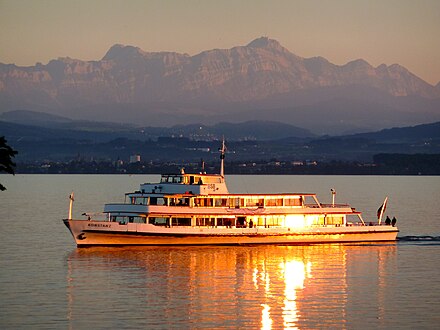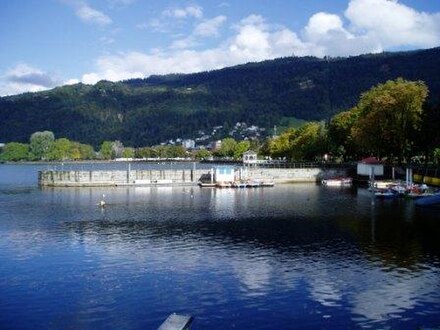Lake Constance - lake in Germany, Switzerland and Austria
The popular tourist region of Lake Constance (German: Bodensee) spans three countries. It is the third biggest lake in Central Europe and is on the path of the Rhine River. The lake shore is shared between the German federal-states Baden-Württemberg and Bavaria, the Austria federal-state Vorarlberg and Eastern Switzerland.
Cities

Germany
Most of the German part of Lake Constance is covered in Bodensee Region.
- Radolfzell (on Zellersee)
- Überlingen (on Überlinger See)
- Konstanz — the city on the German side of the German-Swiss border, is a beautiful city, noteworthy for its cathedral and ancient houses and shops. Its vibrant centre (in which live music almost always plays during the day) and harbour, dominated by the statue of Imperia (who holds the Kaiser in one hand and the Pope in the other) make Konstanz a fantastic city to visit. Konstanz has a palpable Mediterranean feel to it.
- Meersburg — good wine area, historic town and castle
- Friedrichshafen — Zeppelin museum
- Lindau — the beautiful old town of this city is on a small walkable island
Austria
- Bregenz — world-famous floating stage on the lake; known for many cultural events; local mountain with great views
Switzerland
- Stein am Rhein (on Untersee)
- Romanshorn
Islands
There are eleven islands of which Reichenau is the biggest.
- Mainau (in Germany) — flower island
- Reichenau (in Germany) — vegetable island and on the UNESCO World Heritage List for its abbey
Understand
All three nations have developed a specific culture around their part of the shore.
The lake is divided into three main parts: the Obersee ("upper lake"), which covers the main area, the Untersee ("lower lake") in the south-west and the Seerhein, which is the short part that connects the first two bodies of water near Konstanz. The part of the Obersee in the north-west is referred to as Überlinger See and the ferry link between Konstanz and Meersburg approximately defines its boundary. The Rhine feeds into the lake at the south-eastern end and exits in the west. It is the third largest freshwater lake in Europe after Lake Balaton and Lake Geneva. It is 63km long and 14km wide and the deepest part is at 252m.
Lake Constance is also notable for the boundaries not being agreed upon by the three countries having a shoreline on it. In practice this has few effects for the traveler because none of the countries in question grants ius soli citizenship and questions of migration are mostly irrelevant due to the Schengen Agreement. Furthermore Germany, Austria and Switzerland routinely cooperate in cross-border law enforcement and disaster relief.
Its German name, Bodensee, derives from the town of Bodman, whereas the international name is derived from the city of Konstanz and was adopted mainly by the Roman-Catholic world after the Council of Constance.
The lake is also a major source of drinking water for the surrounding regions.
Talk
German is spoken all the way around the lake. In the Swiss towns, people normally speak the Swiss German dialect but will be able to understand and speak high German. Most people in this area speak some English, especially young people and people working in the tourist industry.
Get in
By plane
The closest commercial airport is in Friedrichshafen (IATA: FDH).
Other relevant airports within about 2 hours' drive of the lake are in Memmingen (IATA: FMM), Stuttgart (IATA: STR), Munich (IATA: MUC), Zurich (IATA: ZRH) and Basel (IATA: EAP).
By train
There are trains going around the lake and stopping in most cities of interest. The most important junctions are at Radolfzell, Konstanz, Friedrichshafen, Lindau, Rorschach, Romanshorn and Kreuzlingen. (None of these stations are big; they are simply where various train lines meet.)
Get around
By boat

The major boat/ferry operators are:
- Bodensee-Schiffsbetriebe (Germany)
- Vorarlberg-Lines Bodenseeschifffahrt (Austria)
- SBS Schifffahrt (Switzerland)
The fastest boat crossings are:
- The car ferry between Meersburg and Konstanz (for cars, bikes, pedestrians). Runs several times an hour from 06:00 until 24:00, and once an hour from 00:00 until 06:00. Driving your car onto a big boat to cross a wide body of water is very civilized excitement. It's a delightful quarter-hour ride with cars, trucks, motorcycles, motorbikes, bicycles, and pedestrians. The upper-deck lounge sells coffee, sandwiches, snacks, and cold drinks. Crossings are frequent and you shouldn't have to wait long as there is often a ferry loading when you drive onto the slip. Even at night times, ferries cross the lake hourly. If you travel by foot, be aware that buses might not be available all night, while ferries still are. There are usually taxi cabs waiting around the ferry docks though. Tickets for passengers cost €3, for cars between €8 and €13.90 depending on the size of your vehicle, and for bikes €2.30.
- The car ferry between Friedrichshafen and Romanshorn (for cars, bikes, pedestrians). Runs hourly from approx. 05:30 until 22:30 (slightly reduced hours on weekends/holidays/winter season). Tickets for passengers cost €9.20 or Fr. 10.20, for bicycles €6.10 or Fr. 7.50, and for cars (including the driver) from €31.40 or Fr. 34.50.
- The katamaran between Friedrichshafen and Konstanz (for bikes, pedestrians). Runs once an hour from 06:00 until 19:00. The journey takes about 50min. Tickets cost €10.50 for adults, and €4.80 for bicycles.
There are also more relaxed crossings between many cities and towns on the lake, giving you more time for a beer, meal, or even a nap out on the sunny top deck. These boats normally only run from April until October and don't run at night.
A particularly nice time to be out on the lake is on a sunny day when there is a good view of the Alps.
By train
All cities and many towns on the Bodensee are serviced by the three national railroads of Germany, Austria and Switzerland. The best service (amount of time spent between stops) is by far better in Germany and Austria than on the Swiss side. Lindau, Friedrichshafen, Konstanz and Bregenz all offer major connections further on into Germany, Austria and Switzerland.
Consider the Euregio Bodensee day ticket which offers you unlimited rides on trains/buses around Lake Constance and discounts on specific ferries.
By bicycle
The infrastructure for bicycles is well maintained and cycling along the lake is easy since it is mostly flat. The Bodensee-Radweg ("Lake Constance cycle path") is a 260km long cycle path around the lake and many parts are separated from the other traffic. Shorter options for cycling around the lake are possible by skipping the Untersee (reducing the route by about 75km) or by taking the ferry to skip the Überlinger See (reducing the route by about 65km).
In summer it can get very crowded especially when you want to take your bicycle on the train. You should plan for alternative train connections in case there is no space left.
See
 The Bodensee and its shores are very beautiful in a quiet, cultivated way. The views are serene, not spectacular. If you want dramatic scenery, drive a couple of kilometers south into Switzerland or south-west to Upper Bavaria (Allgaeu) and Austria, (Vorarlberg) and visit the Alps. The area sits in a kind of bowl and tends to be very foggy in the winter months.
The Bodensee and its shores are very beautiful in a quiet, cultivated way. The views are serene, not spectacular. If you want dramatic scenery, drive a couple of kilometers south into Switzerland or south-west to Upper Bavaria (Allgaeu) and Austria, (Vorarlberg) and visit the Alps. The area sits in a kind of bowl and tends to be very foggy in the winter months.
- The Stilt house museum in Uhldingen-Mühlhofen.
- Harbour and old town in Lindau.
- Kunsthaus Bregenz (KUB). A museum in Bregenz exhibiting contemporary art often specifically made or adapted for the museum.
Do

- If you want to spend a pleasant afternoon swimming and sunbathing go to a beach. Buy an ice-cream cone. Watch people change into their bathing suits right out in the open (this is Europe). Doze on the grass. See how many sailboats you can count in one minute.
- Lake Constance cycle route. Opens up this entire region to the cyclist mainly along its own routes along the lakeshore.
- Hiking. The Pfänder (1064m) is accessible from Bregenz and offers great views of the lake.
- Wine. Explore the vineyards along the lake especially around Meersburg and Hagnau.
- Floating Stage. Go to an open-air opera performance on the lake in Bregenz.
Buy
Eat
- Bodensee Schifffahrt. Restaurant on cruise boats
Drink
Typical wines from the region are Müller-Thurgau (white wine), Weißburgunder (white wine) and Spätburgunder (red wine) among others.
Stay safe
Go next
Germany
- Ravensburg — medieval city famous for the jigsaw puzzles made there
- Wangen im Allgäu
Switzerland
- St. Gallen
- Schaffhausen — with the Rhine Falls
